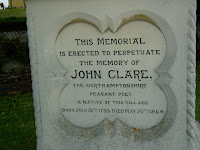Pilgrims to Helpston who have beaten a path from Clare's cradle to his grave may have paused halfway at his third memorial in the village, the stone monument at the crossroads, and wondered how and when it came to be there. The answer is that it was erected by public subscription 120 years ago. This information is recorded in several places (pre-eminently in Whellan's History of Northamptonshire) , and can be confirmed by various documents in the Peterborough Museum, including the original working drawings of the monument, signed by A. Sykes and dated June 1869. The earliest published sketch of the monument that I know is Butterworth's in the Leisure Hour, December 1897, p103, but a fine photograph of it by Marriott's Studio was exhibited at the Clare Centenary four years earlier, and is still on show at the Peterborough Museum.
Within a few weeks of Clare's death plans were being made by friends and admirers to perpetuate his memory in the village. The main project was to raise funds for a suitable gravestone, and in August of 1864 local newspapers like the Stamford Mercury, as well as the Athenaeum in London, were able to announce the formation of a committee for that purpose, the secretary being Mr. J.W. Edgson of Market Deeping. (Interestingly, the designer of the gravestone was reported to be Michael Drury of Lincoln, the son of the Stamford bookseller Edward Drury.) That project having been completed three years later (July 1867), the £50 remaining in funds was put towards a memorial to be prominently placed in the village. Further donations for this purpose were invited by the two prime movers, Mr. Spencer of Woodcroft Castle and Mr. Bellairs of Helpston Manor. What the final cost was I do not know, but the monument, with its distinctive Early English configuration (some have found it rather ugly) of rectangular and cylindrical forms, adorned with imitation lancet windows and a carved finial, duly took its place opposite the village cross in 1869.
It was not long before the monument began to show signs of wear. In 1887 a query from John Page in the correspondence columns of the Northampton Herald drew a reply by John Odling (24th April) transcribing the fading inscriptions on the memorial and noting that it was "liable to serious damage" and had already suffered from "the village lads climbing about it, and by their stone-throwing." He recommended it be "surrounded by palisadings." The following year John Page took the matter up by writing to the Northampton Mercury (14th January) to com¬plain that the memorial had "suffered much mutilation at the hands of mischievous boys," and to the Kettering Observer (3rd August) to suggest that a restoration committee be got together to protect it. Meanwhile another correspondent had described the memorial in the Peterborough Express (18th July) as being "in a very delapidated condition" and needing to be "fenced around."
By the time of the Clare Centenary five years later, similar letters were still appearing in the papers. One dated llth March 1893 in the Peterborough Express lamented that the memorial "evidently forms a rendezvous for the boys of the neighbourhood" arid that its inscriptions had become "almost unreadable." The Centenary Exhibition Catalogue, however, was pleased to announce (p28) that railings to go around the monument were being designed by pupils of the Peterborough School of Art. Of these plans nothing came, and energies were diverted to honouring Clare's cottage with a plaque, which was eventually put up in 1921 (26th May).
The condition of the memorial continued to deteriorate until 1935, when funds were raised by Bessie Garfoot of Helpston to have it restored. A photograph of work-in-progress was published in the Peterborough Advertiser of 23rd August, 1935, under the caption "Cleaning up the Clare Monument", and an account of the unveiling ceremony may be found in the Peterborough Citizen of 3rd September, together with a couple of photographs of the occasion. The subject of railings came up again in a speech by Mr. J.W. Bodger of the Peterborough Museum, who noted that "Boys will be boys, and the very steps of the memorial have been climbed, and tyres and old hats lodged on it. It is for the Parish Council to set to work and put iron railings round the memorial, as ought to have been done years ago." Sir Richard Winfrey, presiding over the ceremony, supported the idea. As the Citizen records: "If the Council could not supply the money out of the Parish rates, he would not mind starting a subscription list for the purpose. (Loud applause.) He asked the Council to prepare an estimate for the work. (Applause.) ....Mr. Crowson promised to bring the matter of the railings before the next meeting of the Parish Council. (Applause.)"
Half a century later there are still no railings, and I dare say the village lads still make a nuisance of themselves. But I wonder: would Clare much mind? He was a village lad himself once, and would probably have preferred village lads around his memorial to iron railings! The goodwill of those who erected and later restored his monument is something that all members of the Society will respect, but I believe the existence of the Society itself is better testimony to the endurance of Clare's memory than any monument of stone.
JCS Newsletter No. 22 (November 1988)
One is reminded of Charles Causley's poem "At the Grave of John Clare" - the pertinent excerpt below:
O Clare! Your poetry clear, translucent
As your lovely name.
I salute you with tears.
And coming out on the green from the Parting Pot,
I notice a bicycle-tyre
Hanging from the high stone feathers of your monument.

